[/caption]The first Orion spacecraft has just been shipped from NASAs Michoud Assembly Facility in New Orlean’s to a Lockheed Martin manufacturing facility in Denver for crucial tests to simulate the harsh environment of deep space.
The Orion crew cabin – know as the Ground Test Article or GTA – was shipped by truck and will arrive in Denver on Feb. 14 according to a Lockheed Martin spokesperson.
Orion is NASA’s next generation crew vehicle and will eventually replace the Space Shuttle system after the looming retirement of the three orbiter fleet, now reset to mid 2011.
The Orion crew exploration vehicle is capable of supporting missions to low Earth orbit (LEO), the Moon, Asteroids and Deep Space.
The next step at Denver is to install the heat shield and thermal protection backshell. The pathfinding vehicle will then be subjected to performance testing inside the acoustic and environmental testing chamber. The testing exercise ensures the vehicle can meet the challenges of ascent, on-orbit operations and safe landing.
“This is a significant milestone for the Orion project and puts us on the right path toward achieving the President’s objective of Orion’s first crewed mission by 2016,” said Cleon Lacefield, Lockheed Martin vice president and Orion program manager. “Orion’s upcoming performance tests will demonstrate how the spacecraft meets the challenges of deep-space mission environments such as ascent, launch abort, on-orbit operations, high-speed return trajectory, parachute deployment, and water landings in a variety of sea states.”
Engineers for Lockheed Martin successfully finished the initial construction and testing phase for this prototype Orion crew cabin at New Orleans. The final pieces of the Orion GTA were welded together in late May 2010 using a state of the art friction stir welding process. See photos below from my inspection tour of the newly welded Orion GTA.
The spacecraft underwent proof pressure testing this past fall. Several mass and volume simulators including the parachutes were installed by the technical team to ready the capsule for shipment.
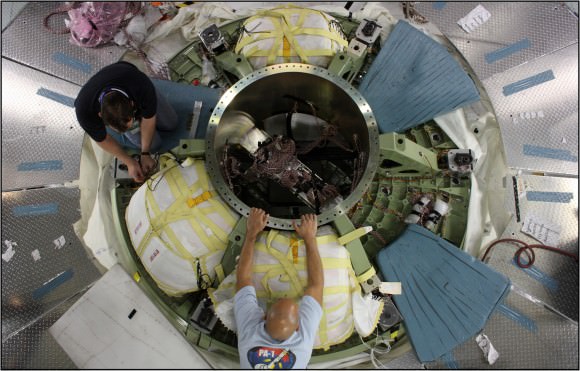
In Denver, the vehicle will be bombarded with acoustic energy and vibrations to simulate flight like situations that correlate the structural environment inside and outside the vehicle. The tests will determine if the spacecraft was properly designed to survive the harsh rigors of spaceflight. Lessons learned will be incorporated into the tools and manufacturing processes that will eventually lead to a human rated production vehicle.
The GTA vehicle will then be transported to NASA’s Langley Research facility for drop tests to simulate, validate and certify a variety of water landing scenarios at the new Hydro Impact Basin. The Langley facility will be used to test and certify water landing for all human-rated spacecraft for NASA according to Lockheed.
NASA and Lockheed hope to launch the first unmanned Orion test flight in 2013 if the budget allows. Construction of the service module and other key components is in progress.
Orion has achieved other significant development milestones in the past year.
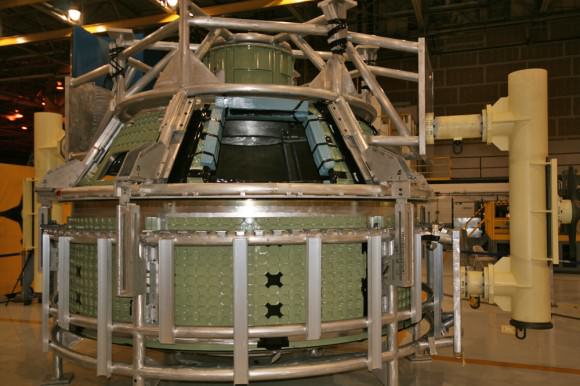
The emergency abort rocket was successfully tested on May 6, 2010 at the U.S. Army’s White Sands Missile Range near Las Cruces, N.M. The abort rocket is bolted atop the crew cabin and is designed to pull the capsule away from the launcher in a split second in an emergency and save astronauts lives.
“The Phase 1 Safety Review was completed in June 2010 and formally acknowledges that Orion’s design meets all of NASA’s critical safety requirements for a human-rated space flight vehicle for flights to low earth orbit (LEO), lunar and deep space missions,” according to Larry Price, Orion Deputy Program Manager at Lockheed Martin.
In the past year the Orion budget has been cut significantly by NASA due to lack of funding from the federal government and the outlook for future funding is uncertain. The new Congress is aiming to cut NASA’s research and development budget even further.
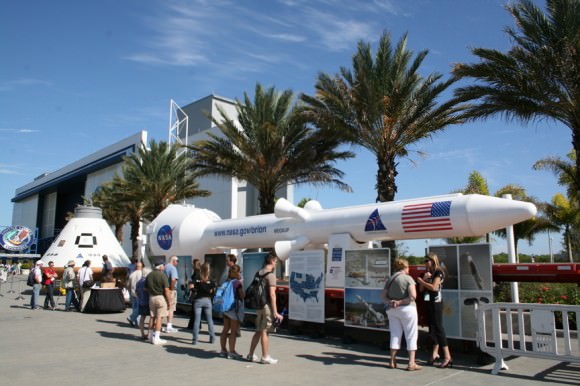
Lockheed Martin Space Systems Company is the prime contractor for Orion and designed and built the GTA as part of a multiyear contract awarded by NASA worth some $3.9 Billion US Dollars. The goal is to produce a new, US-built manned capsule capable of launching American astronauts into space in the post shuttle era.
As soon as the shuttles are retired – for lack of money – the United States will have no capability to loft American astronauts to the International Space Station (ISS) for at least several years. NASA – and all other ISS partners – will be wholly dependent on the Russian Soyuz capsules for launching astronauts to the ISS until either the Orion or commercially developed space taxis such as the Dragon spacecraft from SpaceX are ready for flight. The first operational unmanned Dragon was test flown in Dec 2010.
The Obama Administration sought to cancel Orion in Feb. 2010 as part of NASA’s Project Constellation Return to the Moon program, but then decided to continue Orion’s development after the cancellation proposal met strong bipartisan opposition in Congress.
Orion was to have been launched atop the Ares 1 rocket which has now been officially cancelled. NASA has started the design of a replacement for the Ares 1 which will most likely be a shuttle derived vehicle. Congress has mandated that the first test flight of the still undefined heavy lift rocket must take place by 2016.
Alternatively, Orion could be launched atop a Delta 4 Heavy booster after the rocket is man-rated.
Orion Crew Vehicle Construction Video
Watch this video to see how the first Orion spacecraft was constructed from pieces at NASA’s Michoud Assembly Facility in New Orleans. Credit: NASA
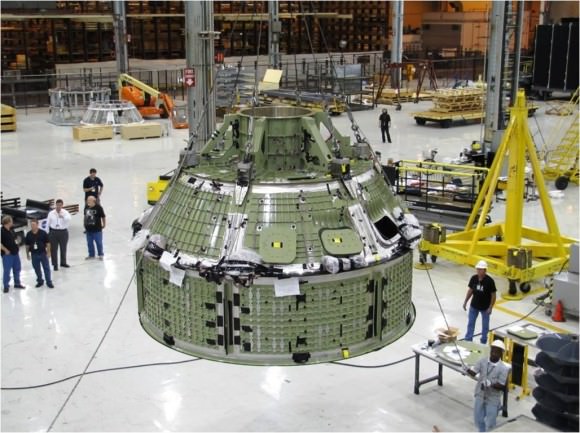
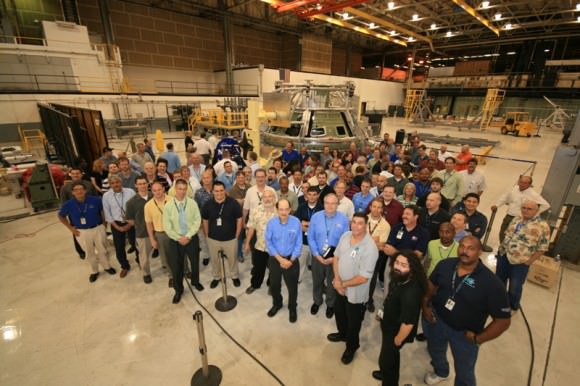

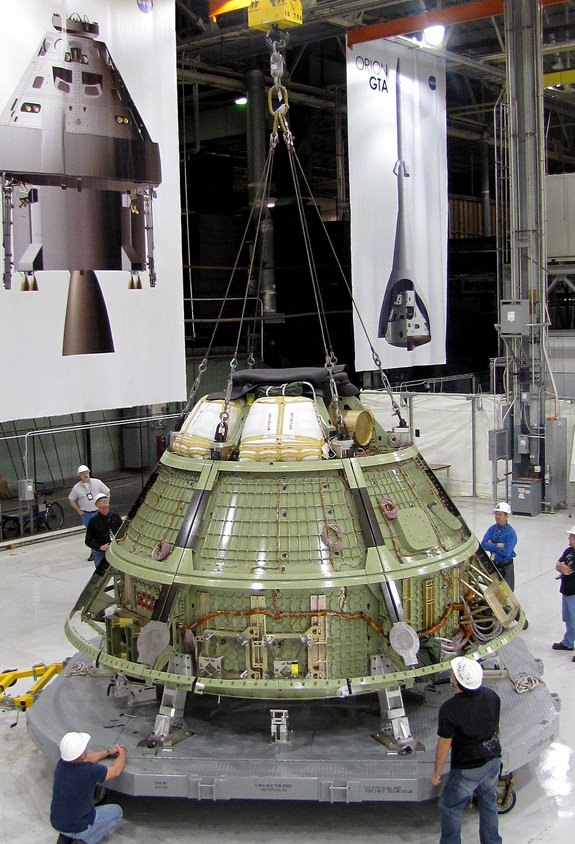
Ok this may be a stupid question but I’ve gotta know. Why is it that NASA always has to reinvent the wheel? With aircraft once you have a proven airframe you can continually upgrade and modernize the components. What you have is something like the F-14 Tomcat, or better yet the B-52 bomber. The B-52 airframe is older than my mother and I believe the F-14 has about 10yrs on me, (I’m 32 and too lazy to fact this on google atm.) However by modernizing the engines, electronics, controls, weapon systems, navigation, radar, etc, etc, etc, you have a world class war plane.
So why can’t we dust off a Saturn 5 and an Apollo capsule modernize them and have someone back on the moon in 2 years?
I realize this is a gross over simplification (it’s after midnight here and I’m posting from my blackberry.) That aside I fail to see a serious hole in my logic.
It’s not only a manned flight phenomena either, take the exploration of Mars. The Spirit and Opportunity rovers have got to be in the top 5 maybe top 3 of mankind’s all time best engineered vehicles. Why haven’t we built a half dozen more equipped with science payloads designed to operate for 2 to 3 years instead of 3 months?
Instead our follow up mission is Curiosity a $2.5 billion+ nuclear powered SUV? (PLEASE, PLEASE, Lord tell me some of that money is paying someone to double check all the figures being used to get the thing there are done with the same system of measurement!!)
I agree with you. It is a waste of money to reinvent the wheel again and again.
It is possible to reuse old design as long as you are not interrupting the production (know-how and designs are then transmitted over times). That’s what Russian are doing for a long time with Soyouz. Same thing with old military blue print such as C130 or F16. It doesn’t mean that you are not losing part of the information (ESA is struggling for 7 years to re-design a Soyouz launch pad) but you have cheap and reliable hardware at disposal.
My personal opinion : large company probably prefer to lobby the administration to lauch expensive R&D programs (remember Constellation budget ?) than keeping alive old concepts. Atlas and Delta rockets are still alive thanks to Air Force needs, not NASA.
Yes but with NASA they went and build the shuttle so they have lost all the engineers that understood the Saturn V. The people developing the Orion do not have the experience to do this.
If they would have continued the Apollo missions, by now they would have the same experience as the Russians have with their rockets.
“The B-52 airframe is older than my mother and I believe the F-14 has about 10yrs on me,”
And nevertheless, the weren’t the last word in fighters and bombers, even though still in service. Even the classic DC-3 is not the widely-used workhorse it once was. Time, requirements and technology march on.
“So why can’t we dust off a Saturn 5 and an Apollo capsule modernize them and have someone back on the moon in 2 years?”
It would be abut as difficult to recreate that manufacturing technology, as to start from scratch…but the real question is, was that the best way to get to the Moon? Is it one you *want* to re-create?
The Apollo architecture was optimized to get a few people to the Moon and back ‘before the decade is out,’ and before the Soviets, whichever came first. It wasn’t designed for economy and sustainability (dragsters, even with updated technology, make poor trucks). A single-launch, heavy lift to get 2-3 people back on the surface isn’t what we want or need now, Today, it’s a transportation infrastructure, using existing, launchers, orbital refueling and assembly (Example: Gemini spacecraft reached orbital heights up to 850 miles, a record not exceeded until Apollo-8, not with a bigger launcher than the Titan II, but by docking with a separately-launched Agena ‘tug’ that took them there, and back to LEO), to go operate regularly between LEO and anywhere in near-Earth space, including the Moon. (Google ‘Nautilus-X ‘for one example of what the future needs to be, see this for another:
http://ulalaunch.com/site/docs/publications/AffordableExplorationArchitecture2009.pdf )
You don’t want to do ‘Apollo-on-steroids,’ because it’s unaffordable and unsustainable, if you want a continuous human presence there, and not merely “have someone back on the moon in 2 years”. Unfortunately, Apollo has warped our thinking into the mindset that something that looks like it is the best or the only way to get back there. NASA is finally coming to understand this. Certain elements of the Houses of Congress…do not.
That is what they do. They took the Apollo proven capsule design and are now improving it with state of the art technology and materials. And also make it bigger.
I really would love to see a Saturn V equivalent back again. That is the most beautiful rocket they ever built.
Curiosity does not have a nuclear power generator in the sense like nuclear power plant. It is a RTG which generates heat and this heat is used to create electricity. This RTG has a very long duration and it gives more power off than any size of solar panel can give. Curiosity can operate during winter as a bonus.
Also do realize that the money spent goes back into the US economy. A lot of people get paid here. The telephone repair man, the cleaning lady, the toilet lady, the bus driver, the garagist,…
@ olaf
I know curiosity doesn’t have a nuclear reactor. I’ve worked in the legal too long and tend write everything like you would for a legal pleading, or the polar opposite of the way scientists do.
“Nuclear Powered SUV,” Is an impactful statement of fact which could lend it’s self to mean a fission reactor. So in this setting I see how that was bad form.
To your other point about the money being necessary and useful expenditure I whole heatedly agree. My issue is with the scientific return on that investment. To continue in the Mars thread to plan curiosity’s mission the were studying satellite photos and radar data of I believe 4 sites. I would send the upgraded rovers to all those sights so we would know for sure at which one Curiosity’s unique capabilities and our scientific return would be greatest.
To sum up I’m not against the Curiosity mission or even the price. I’m against the Curiosity mission at this juncture at this price.
I hope this is legible I’m posting from Blackberry which is always a challenge past the first paragraph.
The initial problem with dusting off old designs is that we lost most of the plans and all the workers that built them.
It would be like trying to make an F-14 three decades from now when everyone who’s ever touched one either has Alzheimers or is dead and the only machines left are rusting away in museums. All the specifics would be lost and constructing a new one would cost as much as making a better one.
What do you do?
Well, smart money says you’d opt to take the basic idea and go one better… which is what constellation was attempting.
The second issue became a management problem. Just as with the shuttle you had people trying to build constellation for missions it would never fly and risks it would never face. You end up with an LAS bigger than the ship and tons of unnecessary equipment.
What NASA really needed was strong leadership… A Von Braun type to put his foot down and keep the mission on track. What it got was a guy who decided space leadership decisions were above his pay grade and outsourced it.
While I think these machines have a better chance of success under private management, the question still remains of what we’re going to do with them once the’ve been built. Forever going to the ISS is only a valid excuse so long as the ISS is there.
Top Pentagon Military Officers are also Top Lockheed Martin Salesmen
Not sated after sacking the U.S. Treasury, like locusts our Military Industrial Complex is swarming around the globe seeking new sources of sustinance. In the photo linked below we see U.S. Air Force Chief of Staff General Norton Schwartz presenting a model of the C-130J-30 Super Hercules to Indian Defense Minister A.K. Antony at a ceremony at the Air Force Station at Hindon near New Delhi, India on Saturday (5 February 2011) to mark the induction of the first of six Lockheed Martin C-130J airplanes purchased for the Indian Air Force.
U.S. total debt $55.6 trillion, U.S. federal debt $14.1 trillion, U.S. federal deficit $1.5 trillion, U.S. dollar rapidly losing world reserve currency status, as U.S. politicians bought and paid for by multinational corporations (legalized by Citizens United vs. FEC) cut education, close schools, convert asphalt roads to gravel and accelerate America’s descent into oblivion so they can pay Lockheed Martin and other greed- and graft-infested government contractors billions for Rube Goldberg defense systems and myriad non-defense boondoggles as unnecessary, unaffordable and unjustifiable as our unending wars for oil and profit. And with the open support of Pentagon top brass, the debt for death and destruction will grow to plague nations around the world:
http://watchingfrogsboil.com/top-pentagon-military-officers-are-also-top-l
In the age of automated, robotic production lines a hand crafted and lovingly assembled spacecraft is built. Based on concept that is 60 years old.
There will be no space program worthy of humanity until ‘money’, is no longer part of societal lexicon. However that will require a revolution in world society that is even more abstract and unimaginable then faster then light travel.
damian: “Money” in a general sense is nothing more than a convenient means of barter (IE, it’s easier to set a monetary value for a car than it is to trade 700 chickens for one). Currency is nothing more than pre-fabbed promissory notes. It doesn’t have an intrinsic value, but rather each note can be thought of as representing a set amount of resources in relation to every other note of the same currency (oil, gold, timber, time, energy, food, etc).
Barter exists due to the fact that almost every resource we have is in an economy situation. IE, we don’t have enough of it to go around, and therefore rationing has to occur. Barter is the method that we use to ration resources. We barter one resource (time) for another: lodging, food/water, clothing, and internet are the 4 necessities of life that we trade for most often, with other resources being luxuries of various types that make our lives better, or extend our lives.
As long as we don’t have infinite resources, economy situations will exist, barter will be necessary, and some form of money will exist in order to make bartering easier (note that that doesn’t mean that either Standard Based or Fiat Currencies have to exist, merely that *something* has to exist).
In TV shows like Star Trek the reason that they don’t need money (for the most part) is because they have – to most intents and purposes – infinite resources. Or at least more than they can efficiently use.
Who knows. Maybe Orion could even be launched on a Chinese or ESA rocket?
If I were in the space business, the technology should be able to be flexible enough to satisfy all launch vehicles. It cuts both production costs and the affordability getting into space. Commercially you could sell vehicles and rocket systems to smaller countries wishing to get into low Earth orbit — an make some profit along the way.
“Who knows. Maybe Orion could even be launched on a Chinese or ESA rocket?”
On Ariane perhaps, but what for? Orion would be perfectly happy on an Atlas V to LEO, a Delta IV Heavy (assuming no orbital infrastructure for refueling or other support) for a deep-space (maybe even a Lunar flyby, I’m not quite sure) flight. And those launchers are in production and available right now, no ITAR or other international issues involved.
Lockheed-Martin’s own Orion literature is becoming more launcher-agnostic (especially as the Ares-1 seems to have no real future), as is the Boeing-CST100. Even the SpaceX Dragon isn’t necessarily married to Falcon-9…
“Commercially you could sell vehicles and rocket systems to smaller countries wishing to get into low Earth orbit — an make some profit along the way.”
Boeing (see above) and Bigelow Aerospace (inflatable stations) are working hard on such deals, as we speak…
@ gopher65
Most people wrongly believe that preceding the creation of money (some 3000BC by the Babylonians) some kind of barter system must have operated. In fact what did exist was far more altruistic. Essentially a (gift) economy.
http://en.wikipedia.org/wiki/Gift_economy
Heres a Hypothetical:
I wish to create a model society for a space bound (Arcology), considering this is multi generational project, I wish to employ the best thinkers in the world to come and work for me. However I have no money, but I do have land which is arable and full of raw materials. So setting up a clear charter for the development of space based colonies, I set about creating a model habitat that (unlike present city states) embraces a cyclical model of living as if the resources of this land were the finite resources available in an Arcology. The aim is to provide shelter and food as well as an intellectual and physical pursuit towards a greater goal. ( essentially a new kind of city state)
In return for people coming to work towards this goal I can provide all the necessities for a happy life without a mortgage, or the stress of monetary pursuits. In return the project sells ideas to the world and individuals are encouraged to prosper intellectually. As this is a multi generational project, participation guarrantees future generations access to the space based arcologys when they are built.
Hypothetically, who would care to participate knowing this is a money free zone? Its not a free society, it requires your skills, trade, intellect, labor and participation, however a goal is set in the city charter. What charter for the future does life have in our present society? The pursuit of money and unlimited consumption ?
I’m not sure precisely how a society like this could function, but one thing I am sure of is that in a space based arcology a monetary system is never going to work. And a human space program that requires money as its base motivator will never fulfill our desire for a space based future.
On the reinvention/lobbying/taxpaying moneygrubbing of US space exploration, I hear your pain.
@ damian:
You can’t validate a theory by attacking its contenders, but I have to note that utopias have never existed. Specifically here our link gives no references but ethnograpical, which aren’t reliable since they are social science storymaking on no factual basis.
gopher65 seems to me describe what is and why it is so. We can also see from sources like Gapminder that democracy and markets are successful in taking populations out of poverty.
“Charter”, purpose or goals are what you make of them, but making tools like money and markets your purpose or goal in life seem kind of daft and boring.
I rather see what we can make of them, such as space technology, but more basically what they provide at large at ever increasing efficiency. Starving isn’t a moral or even practical solution for a society, but having access to enough resources is. And we are getting better at this all the time!
It’ll do for the time being(?) that is until we get something more ‘elegant’ flying… Straight up one time use booster rockets are so wasteful… I like the Scaled Composite’s mother ship to altitude for drop launch…. scaled up! Think XB-70 designed in the 21st century….